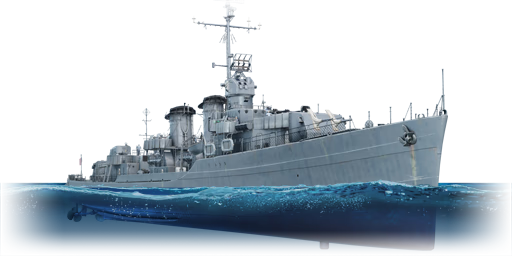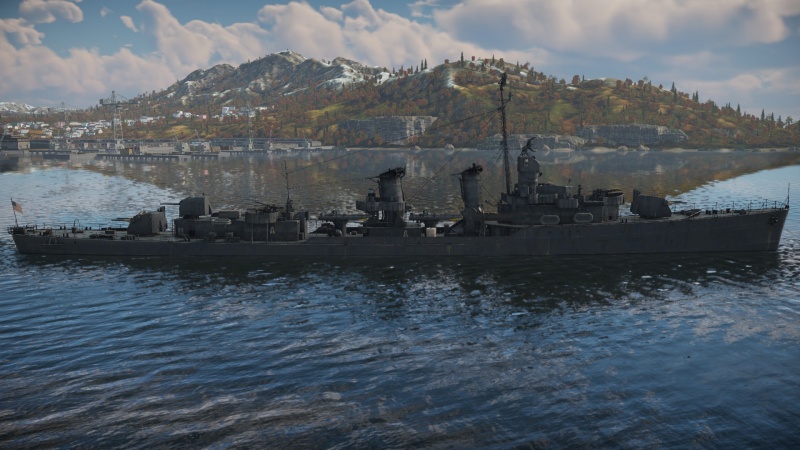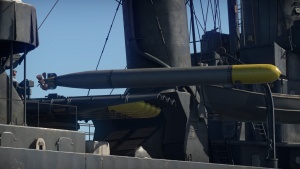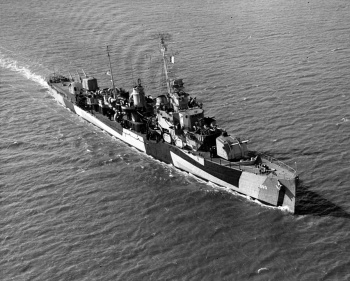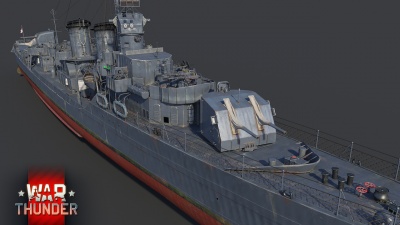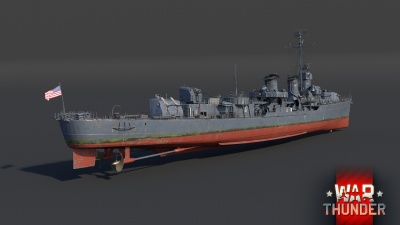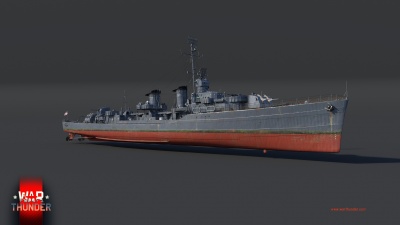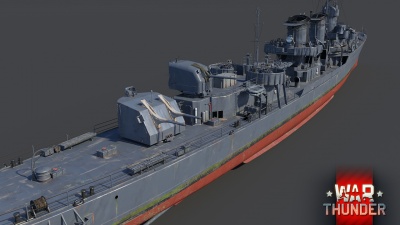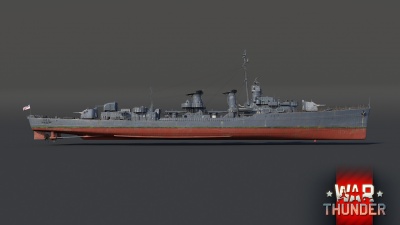Difference between revisions of "USS Phelps"
U106066293 (talk | contribs) (→Primary armament) (Tag: Visual edit) |
(Undo revision 156262 by U106066293 (talk)) |
||
| Line 38: | Line 38: | ||
USS Phelps is equipped with five 5"/38 (12.7 cm) Mark 12 guns mounted in two dual and one single dual-purpose turrets - the dual turrets are mounted one fore and one aft while the single turret superfires over the aft dual turret. These guns are extremely effective against surface and air targets alike, and are capable of firing at an obscene 22 rounds per minute while using first-stage ammunition. The weapon also has a very good vertical and horizontal rotation speed, and is capable of engaging aircraft due to its high-angle capability (up to 85 degrees). | USS Phelps is equipped with five 5"/38 (12.7 cm) Mark 12 guns mounted in two dual and one single dual-purpose turrets - the dual turrets are mounted one fore and one aft while the single turret superfires over the aft dual turret. These guns are extremely effective against surface and air targets alike, and are capable of firing at an obscene 22 rounds per minute while using first-stage ammunition. The weapon also has a very good vertical and horizontal rotation speed, and is capable of engaging aircraft due to its high-angle capability (up to 85 degrees). | ||
| − | The Phelps gets access to the standard three shell types - Mk.34 AAC, Mk.46 Common SP, and Mk.31 AAVT. The SP is typically the best pick for heavier- | + | The Phelps gets access to the standard three shell types - Mk.34 AAC, Mk.46 Common SP, and Mk.31 AAVT. The SP is typically the best pick for heavier-armoured targets such as cruisers, while the AAC shell works better against unarmoured targets due to its large explosive filler. The Mk.31 AAVT is a great option for dealing with air targets due to its proximity fuse - a single direct hit should be enough to destroy an incoming bomber. |
{| class="wikitable sortable" style="text-align:center" width="100%" | {| class="wikitable sortable" style="text-align:center" width="100%" | ||
! colspan="8" | Penetration statistics | ! colspan="8" | Penetration statistics | ||
| Line 193: | Line 193: | ||
'''Operational history''' | '''Operational history''' | ||
| − | After her commissioning, the Phelps escorted the cruisers Indianapolis and Chester with President Franklin D. Roosevelt to the Inter-American peace conference in Buenos Aires. She was then headquartered in the Pacific as the flagship of the First Destroyer Squadron. She was present at the Pearl | + | After her commissioning, the Phelps escorted the cruisers Indianapolis and Chester with President Franklin D. Roosevelt to the Inter-American peace conference in Buenos Aires. She was then headquartered in the Pacific as the flagship of the First Destroyer Squadron. She was present at the Pearl Harbor attack and claimed one aircraft shot down. She was later assigned to escort Task Force 11, with the aircraft carrier Lexington, at the Battle of the Coral Sea. She also performed the less fortunate duty of finishing off the crippled Lexington using torpedoes after the carrier was hit by numerous Japanese bombs.<ref name=":0" /><ref name=":1" /> |
Phelps served as an escort for the American carrier force at the Battle of Midway, where she took no damage. She participated in the landings at Guadalcanal and the ones at Attu, Alaska, where she provided gunfire support to invasion troops. She returned to the southern Pacific to serve as a gunship at the Marshall Islands campaign, where she bombarded Kwajalein and Eniwetok.<ref name=":0" /> In June of 1944, she was part of the bombardment force at Saipan, shelling the island in preparation for American landings. In late 1944, she steamed through the Panama canal and served her final duty as a convoy escort in the Atlantic; she sailed three times with convoys bound for the Mediterranean. Following the War's end, she was decommissioned, and was scrapped in 1947. Phelps received 12 battle stars for her service during the war.<ref name=":0" /><ref name=":1" /> | Phelps served as an escort for the American carrier force at the Battle of Midway, where she took no damage. She participated in the landings at Guadalcanal and the ones at Attu, Alaska, where she provided gunfire support to invasion troops. She returned to the southern Pacific to serve as a gunship at the Marshall Islands campaign, where she bombarded Kwajalein and Eniwetok.<ref name=":0" /> In June of 1944, she was part of the bombardment force at Saipan, shelling the island in preparation for American landings. In late 1944, she steamed through the Panama canal and served her final duty as a convoy escort in the Atlantic; she sailed three times with convoys bound for the Mediterranean. Following the War's end, she was decommissioned, and was scrapped in 1947. Phelps received 12 battle stars for her service during the war.<ref name=":0" /><ref name=":1" /> | ||
=== [[wt:en/news/6560-development-uss-phelps-anti-air-symphony-en|Devblog]] === | === [[wt:en/news/6560-development-uss-phelps-anti-air-symphony-en|Devblog]] === | ||
| − | In the 1920s, the USA acquired a pressing need to equip its fleet with so-called destroyer leaders, i.e. larger and better armed flagships for destroyer flotillas. At the time when the military was trying to convince the US government of the need for these vessels, and the government was arguing that the country already had sufficient numbers of standard destroyers, the London Naval Conference was held to discuss naval disarmament. The conference established an upper displacement limit of 1,850 tonnes for destroyer leaders, which prompted the development of a new ship that would conform to this new international military standard. A preliminary design for the new command ship was ready by November 1930. After almost 18 months of consultations and negotiations, the final design was approved. With a displacement of 1,850 tonnes, the ship carried eight 127mm guns, two quadruple 28 mm guns ("Chicago pianos"), 2 x 4-torpedo launchers and light half-inch | + | In the 1920s, the USA acquired a pressing need to equip its fleet with so-called destroyer leaders, i.e. larger and better armed flagships for destroyer flotillas. At the time when the military was trying to convince the US government of the need for these vessels, and the government was arguing that the country already had sufficient numbers of standard destroyers, the London Naval Conference was held to discuss naval disarmament. The conference established an upper displacement limit of 1,850 tonnes for destroyer leaders, which prompted the development of a new ship that would conform to this new international military standard. A preliminary design for the new command ship was ready by November 1930. After almost 18 months of consultations and negotiations, the final design was approved. With a displacement of 1,850 tonnes, the ship carried eight 127mm guns, two quadruple 28 mm guns ("Chicago pianos"), 2 x 4-torpedo launchers and light half-inch armour. All eight of the planned Porter-class destroyers were built and brought into service by 1937. |
| − | The realities of war revealed several defects in the new leaders, the most significant one was their extremely weak anti-air defence. The ship's 127mm guns were not universal, and the power of the two "Chicago pianos" was woefully inadequate for defending the ship against aircraft attacks. The Porter-class ships underwent two major modernizations intended to enhance the leaders' firepower. By 1944, the ships were markedly different. First of all, the outdated primary guns were replaced with all-purpose weapons, and their number was reduced to five in three turrets. The ship gained a formidable anti-air battery – one quadruple and two twinned 40 mm Bofors guns, six 20 mm Oerlikons, and high- | + | The realities of war revealed several defects in the new leaders, the most significant one was their extremely weak anti-air defence. The ship's 127mm guns were not universal, and the power of the two "Chicago pianos" was woefully inadequate for defending the ship against aircraft attacks. The Porter-class ships underwent two major modernizations intended to enhance the leaders' firepower. By 1944, the ships were markedly different. First of all, the outdated primary guns were replaced with all-purpose weapons, and their number was reduced to five in three turrets. The ship gained a formidable anti-air battery – one quadruple and two twinned 40 mm Bofors guns, six 20 mm Oerlikons, and high-calibre machine guns. Looking beyond armament, the ship's decks were also transformed: the bridge was changed, the height of the rear superstructure was reduced, and reserve torpedoes were removed. Porter-class ships served in this form until they were decommissioned in the early post-war period. |
== Media == | == Media == | ||
| Line 206: | Line 206: | ||
;Skins | ;Skins | ||
| − | |||
* [https://live.warthunder.com/feed/camouflages/?vehicle=us_destroyer_porter_1944 Skins and camouflages for the {{PAGENAME}} from live.warthunder.com.] | * [https://live.warthunder.com/feed/camouflages/?vehicle=us_destroyer_porter_1944 Skins and camouflages for the {{PAGENAME}} from live.warthunder.com.] | ||
| Line 235: | Line 234: | ||
=== References === | === References === | ||
| − | |||
;Citations | ;Citations | ||
<references /> | <references /> | ||
;Bibliography | ;Bibliography | ||
| − | |||
* Destroyer History Foundation. (2000). USS Phelps, DD 360. Retrieved November 19, 2020, from <nowiki>http://www.destroyerhistory.org/goldplater/ussphelps/</nowiki> | * Destroyer History Foundation. (2000). USS Phelps, DD 360. Retrieved November 19, 2020, from <nowiki>http://www.destroyerhistory.org/goldplater/ussphelps/</nowiki> | ||
* Willishaw, F. (1996). USS PHELPS (DD-360). Retrieved November 19, 2020, from <nowiki>http://www.navsource.org/archives/05/360.htm</nowiki> | * Willishaw, F. (1996). USS PHELPS (DD-360). Retrieved November 19, 2020, from <nowiki>http://www.navsource.org/archives/05/360.htm</nowiki> | ||
Revision as of 07:43, 24 February 2023
Contents
Description
The Porter-class, USS Phelps (DD-360), 1944 is a premium gift rank American destroyer with a battle rating of (AB), (RB), and (SB). It was introduced during Update 1.95 "Northern Wind" as a reward for World War Season 2: Attack from the Sea.
General info
Survivability and armour
USS Phelps has below-average survivability for an American destroyer, but still enough to remain competitive at its BR. It has a small crew complement of just 194 crew members, meaning that it tends to die faster in prolonged brawls than other destroyers at its BR. However, it does have the 16 mm anti-fragmentation armour belt found on American destroyers, which greatly enhances its survivability - this belt can block HE shells up to 76 mm and most smaller-calibre AP rounds as well. Note that the ship's guns feature ready-racks directly underneath, similar to other American destroyers - a well-placed hit to these racks can explode the shells and cause serious damage, or even kill the ship directly.
Mobility
In terms of mobility, Phelps is pretty average. The ship has a maximum speed of 84 km/h in AB and 69 km/h in RB, which is pretty average for destroyers, being eclipsed by the Soviet and Japanese destroyers. The ship is relatively responsive in terms of acceleration and turning circle, but again, average among its contemporaries.
| Mobility Characteristics | |||||
|---|---|---|---|---|---|
| Game Mode | Upgrade Status | Maximum Speed (km/h) | Turn Time (s) | Turn Radius (m) | |
| Forward | Reverse | ||||
| AB | Stock | 62 | 26 | ~134.83 | ~256.32 |
| Upgraded | ___ | ___ | |||
| RB/SB | |||||
| Upgraded | ___ | ___ | |||
Modifications and economy
Armament
Primary armament
USS Phelps is equipped with five 5"/38 (12.7 cm) Mark 12 guns mounted in two dual and one single dual-purpose turrets - the dual turrets are mounted one fore and one aft while the single turret superfires over the aft dual turret. These guns are extremely effective against surface and air targets alike, and are capable of firing at an obscene 22 rounds per minute while using first-stage ammunition. The weapon also has a very good vertical and horizontal rotation speed, and is capable of engaging aircraft due to its high-angle capability (up to 85 degrees).
The Phelps gets access to the standard three shell types - Mk.34 AAC, Mk.46 Common SP, and Mk.31 AAVT. The SP is typically the best pick for heavier-armoured targets such as cruisers, while the AAC shell works better against unarmoured targets due to its large explosive filler. The Mk.31 AAVT is a great option for dealing with air targets due to its proximity fuse - a single direct hit should be enough to destroy an incoming bomber.
| Penetration statistics | |||||||
|---|---|---|---|---|---|---|---|
| Ammunition | Type of warhead |
Penetration @ 0° Angle of Attack (mm) | |||||
| 1,000 m | 2,500 m | 5,000 m | 7,500 m | 10,000 m | 15,000 m | ||
| AAC Mk.34 | HE | 36 | 36 | 36 | 36 | 36 | 36 |
| Common Mk.32 | Common | 124 | 103 | 77 | 58 | 46 | 37 |
| SP Common Mk.46 | SP Common | 150 | 125 | 93 | 71 | 56 | 45 |
| AAVT Mk.31 | HE-VT | 36 | 36 | 36 | 36 | 36 | 36 |
| Shell details | |||||||||
|---|---|---|---|---|---|---|---|---|---|
| Ammunition | Type of warhead |
Velocity (m/s) |
Projectile mass (kg) |
Fuse delay (s) |
Fuse sensitivity (mm) |
Explosive mass (TNT equivalent) (g) |
Ricochet | ||
| 0% | 50% | 100% | |||||||
| AAC Mk.34 | HE | 792 | 25 | 0 | 0.1 | 3,220 | 79° | 80° | 81° |
| Common Mk.32 | Common | 792 | 24.49 | 0.01 | 6 | 1,150 | 47° | 60° | 65° |
| SP Common Mk.46 | SP Common | 792 | 25 | 0.01 | 6 | 906.5 | 48° | 63° | 71° |
| Proximity-fused shell details | |||||||||||
|---|---|---|---|---|---|---|---|---|---|---|---|
| Ammunition | Type of warhead |
Velocity (m/s) |
Projectile mass (kg) |
Fuse delay (m) |
Fuse sensitivity (mm) |
Arming distance (m) |
Trigger radius (m) |
Explosive mass (TNT equivalent) (g) |
Ricochet | ||
| 0% | 50% | 100% | |||||||||
| AAVT Mk.31 | HE-VT | 792 | 25 | 0 | 0.1 | 457 | 23 | 3,220 | 79° | 80° | 81° |
Secondary armament
USS Phelps gets access to several 40 mm Bofors guns in dual and quad mounts. These weapons are extremely potent anti-aircraft guns due to their accuracy and punching power. Though these weapons fire slower than the 20 mm Oerlikon or 12.7 mm AN-M2, they more than make up for it due to their hard-hitting 40 mm shells. These guns are capable of shredding aircraft and small boats from ranges of 2.5 km away, though effectiveness will drop off after that range due to the large bullet drop. The guns fire from 4-round clips that reload continuously, meaning that they are capable of continuous fire. However, note that they will eventually jam after firing too long.
| Penetration statistics | |||||||
|---|---|---|---|---|---|---|---|
| Ammunition | Type of warhead |
Penetration @ 0° Angle of Attack (mm) | |||||
| 10 m | 100 m | 500 m | 1,000 m | 1,500 m | 2,000 m | ||
| 40 mm HEFI-T | HEFI-T | 3 | 3 | 3 | 3 | 3 | 3 |
| 40 mm AP-T | AP-T | 81 | 78 | 68 | 58 | 49 | 41 |
| Shell details | |||||||||
|---|---|---|---|---|---|---|---|---|---|
| Ammunition | Type of warhead |
Velocity (m/s) |
Projectile mass (kg) |
Fuse delay (m) |
Fuse sensitivity (mm) |
Explosive mass (TNT equivalent) (g) |
Ricochet | ||
| 0% | 50% | 100% | |||||||
| 40 mm HEFI-T | HEFI-T | 874 | 0.9 | 0 | 0.1 | 67.13 | 79° | 80° | 81° |
| 40 mm AP-T | AP-T | 874 | 0.89 | N/A | N/A | N/A | 47° | 60° | 65° |
Anti-aircraft armament
The Phelps rounds out its anti-aircraft armament with several 20 mm Oerlikon anti-aircraft guns. The 20 mm Oerlikon cannon was the standard light anti-aircraft gun for several nations, including the United States, and replaced the prior AN-M2 Browning machine gun. This weapon is an effective short-range AA gun, and has great firing angles. The guns can easily destroy any aircraft and torpedo boats who stray to close to Phelps. As well, the guns fire from a drum magazine that will need to be reloaded. Because of the magazine design, the gun will not jam with continuous fire.
Additional armament
The Phelps carries two quadruple torpedo launchers each with four Mk. 15 torpedoes with no reloads. These torpedoes were the standard torpedoes for American destroyers and have a relatively high speed, making them effective against larger targets. However, note that their relatively small explosive charge (<300 kg) prevents them from doing massive amounts of damage to cruiser-size targets, unlike the Japanese Type 93 torpedoes. The Phelps also gets access to depth charges, but these are almost entirely useless as they have an extremely short effective range; thus, the best strategy is to avoid equipping them entirely.
Usage in battles
Phelps is a very strong destroyer at its BR, with a significant primary and anti-aircraft armament suite which enables it to fulfill a variety of roles, ranging from ambush / flanking to anti-aircraft defence. However, the ship does not have good survivability among destroyers, so situational awareness is key to maintaining this ship's ability to fight.
Tactics:
Phelps can be used in several roles. In anti-ship combat, a flanker / ambush strategy tends to work best. This strategy makes full use of the ship's extremely-powerful main guns while preserving survivability. In this type of approach, try to head through the sides of maps, particularly behind island cover that prevents enemies from hitting your ship (i.e. the large island formations on South Kvarken). Utilizing choke points, being places that enemy ships tend to head to, is extremely important. Once in position, you can simply wait for enemy destoyers to pop up, and shred them with your heavy main armament. Try to ensure that you always fire first, as the person who fires first will typically win the engagement. Utilize the 5-inch main guns, firing HE, and shred through the crew compartments of enemy destroyers. In the unlikely case that you encounter a cruiser, try to seek the help of teammates, as Phelps cannot compete with cruisers on even terms. Finally, avoid open-sea combat at all costs, because Phelps will do the worst where it cannot make use of island cover.
As well, Phelps can be used in an anti-aircraft and support role. This destroyer has exceptionally powerful anti-aircraft guns, including eight 40 mm Bofors guns which can effectively shred aircraft at ranges out to 5 km. In this type of playstyle, the Phelps does better as a 2nd or 3rd spawn - this means that you spawn the ship late in the battle when enemy players are already switching to aircraft. Stay with your teammates and shoot at enemy aircraft with your main and secondary guns - the 5"/38 main battery can effectively engage aircraft at very long ranges. However, this does take practice, as there is no aim assist for ship guns in RB, and no aim assist exceeding 2.5 km in AB. Stay with your teammates and maintain a 5 km no-fly zone around your battle group.
Pros and cons
Pros:
- Multiple dual-purpose 5"/38 Mk 12 guns with extremely fast fire rate (22 RPM on first stage ammunition)
- Dual-purpose capabilities allowing them to engage aircraft and ships reliably
- Guns have a quick rate of traverse and good firing angles
- Extremely good anti-aircraft armament suite with multiple 40 mm and 20 mm guns
- Gets access to an anti-fragmentation armour belt which dramatically enhances survivability
Cons:
- Relatively weak survivability for a destroyer with just 194 crew members
- Exposed first-stage ammunition storages which can be detonated easily
- Mediocre mobility for a destroyer, slower than many of its contemporaries
- Torpedoes are mediocre, with a relatively short range and a small warhead
History
USS Phelps was a destroyer leader of the Porter-class. She was one of the most active American destroyers of the Second World War, earning 12 battle stars as the Flagship of Destroyer Squadron 1. Following her commissioning in 1936, she served in peacetime duties with the Pacific fleet, and was present at the Pearl Harbor Attack where she shot down an enemy plane. She then participated in the Battle of the Coral Sea, where she scuttled the abandoned carrier Lexington with five torpedoes. She served as an escort during the Battle of Midway, participated in the Marshall Islands campaign and spent the last part of the war as a convoy escort in the Atlantic. She was decommissioned and scrapped by 1947.[1]
Design and construction
The Phelps, named after Rear Admiral Thomas Stowell Phelps, was one of eight Porter-class destroyers used by the US Navy. The ships displaced 1,850 tons, exactly matching the 1,850-ton destroyer weight limitation of the London Naval Treaty. However, she typically displaced over 2,000 tons on combat missions and up to 2,663 tons full load. As a destroyer-leader, the Phelps carried eight 5-inch (127 mm) single-purpose guns on four twin turrets;[2] she was later refitted to carry two 5-inch dual-purpose twin turrets and a single five-inch DP turret at the rear. Her anti-aircraft armament was initially sparse, but was upgraded through the course of the war. Phelps also carried eight 533 mm torpedo tubes in two quad-mounts. She could make a top speed of 37 knots (69 km/h) and had a crew complement of 276.[2]
The Phelps was laid down on January 2nd 1934, and was launched on July 18th 1935. Following the completion of construction, she was commissioned on February 26th 1936.[1][2]
Operational history
After her commissioning, the Phelps escorted the cruisers Indianapolis and Chester with President Franklin D. Roosevelt to the Inter-American peace conference in Buenos Aires. She was then headquartered in the Pacific as the flagship of the First Destroyer Squadron. She was present at the Pearl Harbor attack and claimed one aircraft shot down. She was later assigned to escort Task Force 11, with the aircraft carrier Lexington, at the Battle of the Coral Sea. She also performed the less fortunate duty of finishing off the crippled Lexington using torpedoes after the carrier was hit by numerous Japanese bombs.[1][2]
Phelps served as an escort for the American carrier force at the Battle of Midway, where she took no damage. She participated in the landings at Guadalcanal and the ones at Attu, Alaska, where she provided gunfire support to invasion troops. She returned to the southern Pacific to serve as a gunship at the Marshall Islands campaign, where she bombarded Kwajalein and Eniwetok.[1] In June of 1944, she was part of the bombardment force at Saipan, shelling the island in preparation for American landings. In late 1944, she steamed through the Panama canal and served her final duty as a convoy escort in the Atlantic; she sailed three times with convoys bound for the Mediterranean. Following the War's end, she was decommissioned, and was scrapped in 1947. Phelps received 12 battle stars for her service during the war.[1][2]
Devblog
In the 1920s, the USA acquired a pressing need to equip its fleet with so-called destroyer leaders, i.e. larger and better armed flagships for destroyer flotillas. At the time when the military was trying to convince the US government of the need for these vessels, and the government was arguing that the country already had sufficient numbers of standard destroyers, the London Naval Conference was held to discuss naval disarmament. The conference established an upper displacement limit of 1,850 tonnes for destroyer leaders, which prompted the development of a new ship that would conform to this new international military standard. A preliminary design for the new command ship was ready by November 1930. After almost 18 months of consultations and negotiations, the final design was approved. With a displacement of 1,850 tonnes, the ship carried eight 127mm guns, two quadruple 28 mm guns ("Chicago pianos"), 2 x 4-torpedo launchers and light half-inch armour. All eight of the planned Porter-class destroyers were built and brought into service by 1937.
The realities of war revealed several defects in the new leaders, the most significant one was their extremely weak anti-air defence. The ship's 127mm guns were not universal, and the power of the two "Chicago pianos" was woefully inadequate for defending the ship against aircraft attacks. The Porter-class ships underwent two major modernizations intended to enhance the leaders' firepower. By 1944, the ships were markedly different. First of all, the outdated primary guns were replaced with all-purpose weapons, and their number was reduced to five in three turrets. The ship gained a formidable anti-air battery – one quadruple and two twinned 40 mm Bofors guns, six 20 mm Oerlikons, and high-calibre machine guns. Looking beyond armament, the ship's decks were also transformed: the bridge was changed, the height of the rear superstructure was reduced, and reserve torpedoes were removed. Porter-class ships served in this form until they were decommissioned in the early post-war period.
Media
- Skins
- Images
See also
External links
References
- Citations
- Bibliography
- Destroyer History Foundation. (2000). USS Phelps, DD 360. Retrieved November 19, 2020, from http://www.destroyerhistory.org/goldplater/ussphelps/
- Willishaw, F. (1996). USS PHELPS (DD-360). Retrieved November 19, 2020, from http://www.navsource.org/archives/05/360.htm
| Bethlehem Steel Corporation | |
|---|---|
| Gun Destroyers (DD) | |
| Porter-class | USS Phelps · USS Moffett |
| Fletcher-class | USS Cowell |
| Destroyer Leaders (DL) | |
| Mitscher-class | USS Wilkinson |
| Cruiser, Light (CL) | |
| Omaha-class | USS Raleigh · USS Detroit |
| Heavy Cruisers (CA) | |
| Northampton-class | USS Northampton |
| Portland-class | USS Portland |
| Baltimore-class | USS Baltimore · USS Pittsburgh |
| Des Moines-class | USS Des Moines |
| USA destroyers | |
|---|---|
| Clemson-class | USS Welborn C. Wood · USS Barker · USS Litchfield |
| Farragut-class | USS Aylwin |
| Bagley-class | USS Bagley |
| Porter-class | USS Porter · USS Phelps · USS Moffett |
| Somers-class | USS Somers · USS Davis |
| Fletcher-class | USS Fletcher · USS Bennion · USS Cowell |
| Allen M. Sumner-class | USS Sumner |
| Gearing-class | USS Gearing · USS Frank Knox |
| Mitscher-class | USS Mitscher · USS Wilkinson |
| USA premium ships | |
|---|---|
| Motor torpedo boats | PT-3 · PT-109 · PT-174 · Thunderbolt (PT-556) · PT-658 · PT-811 |
| Motor gun boats | LCM(6) Zippo · USS Douglas · USS Flagstaff |
| Sub-chasers | Carmi (PC-466) |
| Destroyers | USS Welborn C. Wood · USS Wilkinson · USS Bennion · USS Cowell · USS Davis · USS Moffett · USS Phelps · USS Frank Knox |
| Light cruisers | USS Detroit · USS Helena |
| Heavy cruisers | USS Des Moines |
| Battleships | USS Arkansas |


